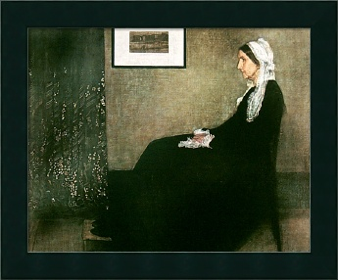Anna McNeill Whistler (1804-1881)
Anna Mathilda McNeill gained world-wide notoriety by doing nothing but posing for her artist son, James Whistler. Today her portrait hangs in the Musee d’Orsay in the center of Paris. Each day hundreds of admiring art lovers stand in front of the large canvas of Anna Whistler, but few know the story of this extraordinary woman who lived in America, Russia, and Great Britain during the 19th century.
To tell her story we must start in Wilmington, NC. Anna’s father had been a physician in Edinburgh, Scotland, before coming to America after the death of his first wife. He soon established a successful practice, bought a house in the country and remarried. Anna was their fifth child who grew up to be an attractive girl with a refined and charming manner. She was generous, kind and devoutly religious. Her bother, William, went to West Point and became good friends with Cadet George Whistler. Upon graduation they both worked for the Baltimore and Ohio Railroad. George’s first marriage ended in 1827 when his wife, Mary, died. Anna McNeill had been good friends with Mary Whistler and was fond of his 3 children. She also cared deeply for George. They were married in 1831. George resigned from the army at the rank of major and moved to Lowell, Massachusetts. In July 1834 a son, James, was born. Two years later a second boy, Willie, came along, making five children in the house.
In 1842 Major George Whistler became the Chief Engineer on the railroad being built from St. Petersburg to Moscow. Anna and the family joined George in Russia a year later. The Whistlers were very happy for the next six years. They lived comfortably and had many servants to help Anna with running the house and caring for the children.
In April 1849 Major George Whistler died. At the end of July, Anna McNeill Whistler returned to America with James and Willie. She was in mourning. In fact she wore mourning clothes the rest of her life. By this time James had decided to be an artist, but his mother insisted he be an engineer like his father. At the age of 17, James Whistler entered West Point. Three years later he was discharged for failing chemistry. “Had silicon been a gas, I would be a major-general,” James Whistler once said. Intent in studying art, James left for Paris, never to return to America. Willie, in the meantime, became a surgeon and when the Civil War started he joined the Confederate Army and spent most of the next four years in Richmond. Anna ran the blockade to see Willie when his wife died and again to join James in London. In February 1865, Willie arrived in London carrying dispatches to the British military and when the war ended in April, he decided to stay with his mother.
It was in the summer of 1871 when a model failed to show up that James Whistler turned to his mother and said, “Mother, I want you to stand for me!” Anna was not strong enough to pose long hours standing. The summer heat and the winter fogs of London had sapped her strength. She was then 67. When the portrait was finished, Whistler called it “Arrangement in Grey and Black.” When it was sent to the Royal Academy it was nearly rejected.

It would be another twenty years before Whistler’s portrait of his mother was purchased to hang in the Louvre and eventually in the now famous art museum, Musee d’Orsay. Anna Whistler lived until 1881, encouraging her artist son all the time to continue painting. James Whistler died in 1903 a successful artist, but feeling that he had not lived up to his mother’s expectations.
